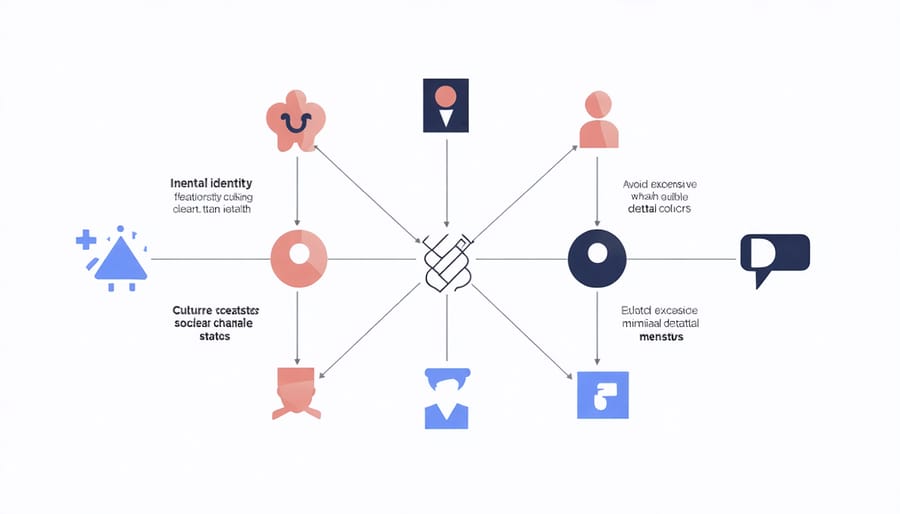Intersectionality stands at the crossroads of modern social discourse, challenging our understanding of how different aspects of identity – including gender, race, class, and sexuality – intersect to shape lived experiences. While some herald it as a crucial framework for addressing systemic inequalities and improving men’s mental health and other social issues, others question whether its application may inadvertently create new divisions or oversimplify complex human experiences.
This nuanced debate has profound implications for healthcare delivery, education policy, workplace equity, and social justice initiatives across Canada. Rather than viewing intersectionality as inherently good or bad, a more productive approach examines how this analytical tool can be effectively utilized while acknowledging its limitations and potential drawbacks.
As communities become increasingly diverse and interconnected, understanding the practical applications and potential pitfalls of intersectional approaches becomes crucial for healthcare providers, policy makers, and community leaders. This balanced examination explores how intersectionality shapes our approach to mental health treatment, social services, and community support systems, while considering both its benefits in recognizing complex identities and its challenges in practical implementation.
The discussion addresses critical questions: How can intersectional approaches enhance service delivery without creating unnecessary complexity? What evidence supports or challenges intersectional interventions in healthcare? How do we balance individual identity recognition with the need for practical, scalable solutions?
Understanding Intersectionality in Mental Health Care
Key Components of Intersectional Analysis
Intersectional analysis in mental health examines how different aspects of a person’s identity work together to shape their experiences and well-being. Key factors include gender, race, cultural background, socioeconomic status, sexual orientation, and disability status. These elements don’t exist in isolation but interact in complex ways that influence mental health outcomes.
For example, a person’s cultural background might affect how they express emotional distress, while their economic situation could impact their access to mental health resources. Gender roles and expectations within different communities can also influence how individuals seek help and receive support.
Understanding these intersections helps healthcare providers deliver more effective, personalized care. It recognizes that mental health challenges may manifest differently based on various life experiences and social contexts. This approach encourages mental health professionals to consider the whole person rather than focusing on single aspects of identity.
By acknowledging these multiple layers of identity and experience, practitioners can better understand barriers to care and develop more inclusive and effective treatment strategies that resonate with diverse populations.

The Canadian Context
In Canada’s diverse healthcare landscape, intersectionality plays a crucial role in understanding how multiple identities shape mental health experiences. Our multicultural society presents unique challenges and opportunities for implementing intersectional approaches in mental health care. Research shows that cultural influences on mental health significantly impact treatment outcomes among different Canadian communities.
Indigenous peoples, immigrants, and various ethnic groups often face overlapping barriers to accessing mental health services. These barriers can include language differences, cultural stigma, and systemic inequities within the healthcare system. The Canadian Mental Health Association has recognized that addressing these intersecting factors is essential for providing effective care.
Canadian healthcare providers are increasingly incorporating intersectional frameworks into their practice, considering factors such as geographical location, socioeconomic status, and cultural background. This approach has shown promising results in improving mental health outcomes, particularly in urban centers with high diversity.
However, implementation challenges remain, especially in remote and rural areas where resources are limited. Moving forward, Canadian mental health professionals must continue developing culturally sensitive and intersectional approaches while ensuring accessibility across all communities.
Benefits of Intersectional Approaches
Improved Treatment Accuracy
Intersectional approaches significantly enhance the accuracy of mental health diagnoses and treatment plans by considering how multiple aspects of a person’s identity interact to shape their experiences. When healthcare providers examine the interplay of factors like gender, culture, socioeconomic status, and sexual orientation, they can better understand the unique challenges each patient faces.
For example, a treatment plan for anxiety might look different for an Indigenous woman living in a remote community compared to an urban professional dealing with similar symptoms. By acknowledging these intersecting factors, practitioners can develop more targeted and effective interventions that address the specific needs and circumstances of each individual.
Research shows that intersectional treatment approaches lead to better health outcomes and increased patient engagement. Patients report feeling more understood and validated when their healthcare providers consider their full identity spectrum rather than focusing on isolated aspects of their experience.
This comprehensive approach also helps identify potential barriers to treatment that might otherwise go unnoticed. For instance, cultural beliefs about mental health, language barriers, or financial constraints can significantly impact treatment accessibility and effectiveness. By recognizing these intersecting challenges early in the diagnostic process, healthcare providers can proactively develop solutions and alternative approaches that better serve their patients.
Moreover, intersectional treatment methods help reduce misdiagnosis rates by considering how different aspects of identity might influence symptom presentation and interpretation. This nuanced understanding leads to more precise diagnostic assessments and ultimately more successful treatment outcomes.

Enhanced Patient Engagement
Incorporating intersectionality into healthcare practices leads to significantly improved patient engagement and treatment outcomes. When healthcare providers recognize and address the multiple aspects of a patient’s identity – including cultural background, gender, socioeconomic status, and lived experiences – they create more meaningful connections and develop more effective treatment plans.
Studies show that patients are more likely to follow through with treatment recommendations when they feel truly understood by their healthcare providers. This is particularly important when working to support men’s mental health, where cultural and societal expectations can create barriers to seeking care.
Cultural competency enhanced by intersectional awareness helps healthcare providers better understand how different aspects of identity interact to influence health behaviors and treatment preferences. For example, a provider might adjust their communication style or treatment approach based on understanding how a patient’s cultural background intersects with their gender identity and economic circumstances.
This deeper understanding leads to:
– Higher attendance rates at follow-up appointments
– Better medication adherence
– Increased participation in preventive care
– More open communication about health concerns
– Greater trust in healthcare providers
When patients feel their complete identity is acknowledged and respected, they become active participants in their healthcare journey rather than passive recipients of care. This collaborative approach results in more sustainable health outcomes and improved overall well-being.
Challenges and Limitations
Practical Implementation Issues
Implementing intersectionality in healthcare and social services requires careful planning and resource allocation. Organizations need to invest in comprehensive staff training programs that cover cultural competency, gender sensitivity, and awareness of various social determinants of health. This typically involves ongoing professional development sessions, workshops, and regular updates to keep pace with evolving understanding of diverse community needs.
Healthcare providers and social workers require additional time for patient consultations to properly address multiple intersecting factors affecting health outcomes. This may necessitate adjustments to scheduling systems and workflow processes. Organizations should also consider developing or updating intake forms and assessment tools to capture relevant information about patients’ various social identities and lived experiences.
Technology and data management systems need updating to track and analyze intersectional data effectively. This includes software that can handle multiple demographic variables and their interactions, while maintaining patient privacy and confidentiality.
Resource requirements extend to creating inclusive physical spaces and communication materials that reflect diverse community needs. This might include multilingual signage, accessible facilities, and culturally appropriate health education materials.
Success in implementing intersectional approaches often depends on building partnerships with community organizations and cultural groups. This network-building requires dedicated staff time and resources but proves invaluable in providing comprehensive, culturally sensitive care.
Avoiding Oversimplification
While intersectionality helps us understand complex social experiences, it’s important to avoid falling into the trap of oversimplification. Each person’s lived experience is unique, and assuming that someone faces specific challenges solely based on their intersecting identities can lead to harmful stereotyping.
For example, not all women from visible minority backgrounds face the same barriers or have identical experiences in the healthcare system. Individual circumstances, personal resilience, support networks, and various other factors contribute to how people navigate their health and wellness journey.
To prevent oversimplification, healthcare providers and community members should:
– Listen to individual stories without making assumptions
– Recognize that experiences within groups can vary significantly
– Acknowledge that intersecting identities are just one part of a person’s complete story
– Consider how personal circumstances and environmental factors influence outcomes
– Remain open to learning from each person’s unique perspective
It’s also crucial to remember that intersectionality is a framework for understanding complexity, not a tool for categorizing people. When used thoughtfully, it helps us recognize and address disparities while honoring individual experiences. The goal is to create more inclusive and effective health services that respond to real needs rather than presumed challenges based on group membership.
Practical Applications for Mental Health Professionals
Assessment Tools
Several evidence-based mental health assessment tools have been developed to evaluate intersectional experiences effectively. The Intersectional Discrimination Index (InDI) helps measure various forms of discrimination across multiple social categories, while the Intersectional Identity Assessment Tool (IIAT) examines how different aspects of identity interact to influence mental health outcomes.
Healthcare providers commonly use the Cultural Formulation Interview (CFI), which incorporates intersectional perspectives to understand how cultural, social, and personal factors shape an individual’s experiences. This tool helps practitioners develop more comprehensive treatment plans that address multiple aspects of identity and lived experience.
The Minority Stress Assessment Tool considers various intersecting factors that contribute to stress among marginalized populations, including discrimination, internalized stigma, and social support. This helps practitioners better understand the cumulative impact of multiple identity-based stressors.
For community-based assessments, the Intersectional Community Assessment Tool (ICAT) enables organizations to evaluate their services through an intersectional lens, ensuring programs meet the diverse needs of their communities. These tools continue to evolve as our understanding of intersectionality grows, with Canadian researchers actively developing new assessment methods that reflect our multicultural society’s unique needs.

Treatment Planning
When developing treatment plans through an intersectional lens, practitioners should begin by conducting comprehensive assessments that consider multiple aspects of a client’s identity and lived experience. This includes understanding how factors like gender, cultural background, socioeconomic status, and other social determinants of health interact to shape their mental health needs.
Creating effective treatment plans requires collaboration with clients to identify their specific goals while acknowledging how different aspects of their identity may influence their healing journey. Practitioners should remain flexible and adapt evidence-based interventions to align with clients’ cultural values and personal circumstances.
Regular check-ins and progress monitoring help ensure the treatment plan remains responsive to changing needs. This may involve adjusting approaches based on feedback and incorporating culturally appropriate coping strategies that resonate with the client’s background and experiences.
It’s essential to connect clients with appropriate community resources and support networks that understand their unique intersecting identities. This might include cultural organizations, support groups, or other service providers who can address specific aspects of their needs.
Documentation should reflect awareness of intersectional factors while maintaining professional standards. Treatment goals should be measurable and realistic, taking into account systemic barriers that clients may face while accessing care or implementing recommended changes in their lives.
The most effective treatment plans recognize that healing occurs within broader social contexts and work to empower clients while acknowledging their individual strengths and challenges.
Intersectionality in mental health care represents both an opportunity and a challenge for practitioners and patients alike. The evidence suggests that considering multiple aspects of identity and experience leads to more personalized, effective treatment approaches. When implemented thoughtfully, intersectional approaches can help healthcare providers better understand their patients’ unique circumstances and create more targeted intervention strategies.
For mental health professionals, the key takeaway is to integrate intersectional awareness into practice gradually and systematically. This can begin with simple steps like updating intake forms to capture diverse identity factors and regularly participating in cultural competency training. It’s essential to maintain a balanced approach that acknowledges intersectionality’s benefits while being mindful of potential implementation challenges.
For patients, understanding intersectionality can be empowering. It provides a framework to articulate their experiences and advocate for more comprehensive care. However, it’s important to remember that intersectionality is just one tool among many for understanding mental health challenges and seeking appropriate treatment.
Moving forward, the most effective approach appears to be one that:
– Embraces intersectionality’s insights while avoiding oversimplification
– Maintains focus on evidence-based treatment methods
– Considers individual circumstances alongside broader social contexts
– Promotes ongoing dialogue between practitioners and patients
– Supports continuous learning and adaptation of treatment approaches
By taking these measured steps, both mental health professionals and patients can harness the benefits of intersectional approaches while minimizing potential drawbacks. The goal remains clear: to provide more effective, inclusive, and personalized mental health care that acknowledges and addresses the complex realities of human experience.

